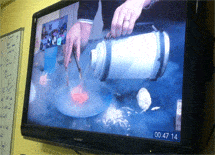With the National Broadband Network (NBN) beginning to be rolled out across Australia, at an estimated cost of $35.9 billion, the general public is quite rightly wondering what they will get for their buck. Well, having just attended the Digital Outreach conference this week I can say from the education perspective that things will change dramatically. Over the past three days, key people from many of the major educational institutions in Australia converged in one tiny room to showcase how video conferencing of live classes over the internet has changed rapidly in the past few years and more importantly, what is going to happen in the near future. The institutions involved were not sideline players in educational outreach; each attending institution regularly see tens of thousands of school students per year, either via traditional excursion to their location or by a specific visit to schools. I was honored to be asked to represent the newly formed NSW working group on video conferencing at this event, a collaboration of ‘like minds’ not just limited to science education of which includes but not limited to the following:
- Australian Museum
- Questacon
- Powerhouse Museum
- NSW Distance & Rural Technologies
- NSW Chief Scientist Office
- Field Of Mars Environmental Education Centre
- National Film & Sound Archive
- Historic Houses Trust
- Australian Mineral & Fossil Museum
Fizzics Education has been running science classes to remote schools via video conference since early 2010. Since our first early conferences we have now presented to well in excess of 150 Australian schools. We are now beginning to provide these classes to schools in the USA and beyond. Yet we really have not even begun to fulfill the demand for high quality science outreach, in Australia or abroad. One of the misconceptions about video conferencing is that it is a ‘video’… nothing could be farther from the truth. A video conference is about interacting with the speakers, i.e. students asking questions and getting answers all in real-time. It’s about authentic lessons, kids getting to run experiments in their room while being guided by us even though we’re possibly over 1000 km away – or even another country! This is not just limited to science teachers convening events; the ReefHQ runs conferences where you can speak live with a diver in their tropical reef tank, Literature Live lets students speak with renowned authors, Taronga Zoo can showcase their animals and more. It has nothing to do with passive learning, it’s about truly engaging experiences that students otherwise would never have access due to geographic isolation or socioeconomic factors.

Video conferencing with Fizzics Education
None of this would be possible without a dedicated service that coordinates, books and evaluates content providers. In this the NSW Distance and Rural Technology unit (NSWDART) is indispensable. With bridge that coordinates over 3000 separate cameras that link directly into NSW Public schools, DART provides the technical expertise and a common platform for content providers to operate within. DART’s charter is specifically to NSW Public Schools, however organisations such as the Catholic Education Office, the Association of Independent Schools and assorted state government education departments are rapidly putting together their own platforms.
So, what has this got to do with the NBN? Simply, the huge bandwidth increase will allow for true high-definition experiences during video conferences. Currently every one of the aforementioned providers are limited by the structural backbone of the current copper and satellite network. HD video conferences need a tremendous amount of bandwidth; think about how long it takes to upload a YouTube video from a standard ADSL connection… you are getting video and audio that takes a couple of minutes to load and yet this is just for a one way stream of data being displayed on a tiny website box on your small laptop computer. Now imagine how much data must be needed to produce a video conference which sends information all at once and both ways between multiple schools (sometimes higher than 20), to fill an entire television screen, screening live without delay or corruption of video/audio and coordinating each speaker in a seemless environment. In schools you can’t use a tiny website box as the students can’t see anything, if you expand the vision to an interactive whiteboard the video becomes grainy and pixellated. Currently the live video streamed to and from schools is not perfect, video and audio streams can get corrupted when internet access is poor… it’s a bit like when your DVD movie is scratched or your CD jumps. Imagine how frustrating it is for educators to have accessed a presentation from the NASA Space Centre in Houston or the Jet Propulsion Laboratory or the Alaskan Sea Life Centre, they’ve had parents to pay for the excursion and only to have it fail because the infrastructure is not working that day. Now multiply that frustration to cover over 10,000 schools in Australia (think of how many students that actually reaches). Once the NBN is rolled out, these frustrations melt away. Not only that, these kind of experiences will be available for you, the reader at home, to access directly in your own room on your plasma TV. I can guarantee companies will setup HD tutoring sessions where your child can speak with experts in their field at a fraction of the cost of a tutor. It is inevitable… it’s just a question of when. Watch this space…
All the best!























Hi Ben,
I couldn’t see the STANSW Young Scientist Awards in your list. It is only open to NSW students but a very good competition for K-12 students covering science investigations, maths investigations, models and inventions.
Hi Matt!
Yep, this a fantastic competition. Added now!
https://www.fizzicseducation.com.au/articles/school-science-competitions/
Very interesting ! Like it !
Glad you enjoyed this! You can check out all of our science classes via video conference here, hope you can join us 🙂